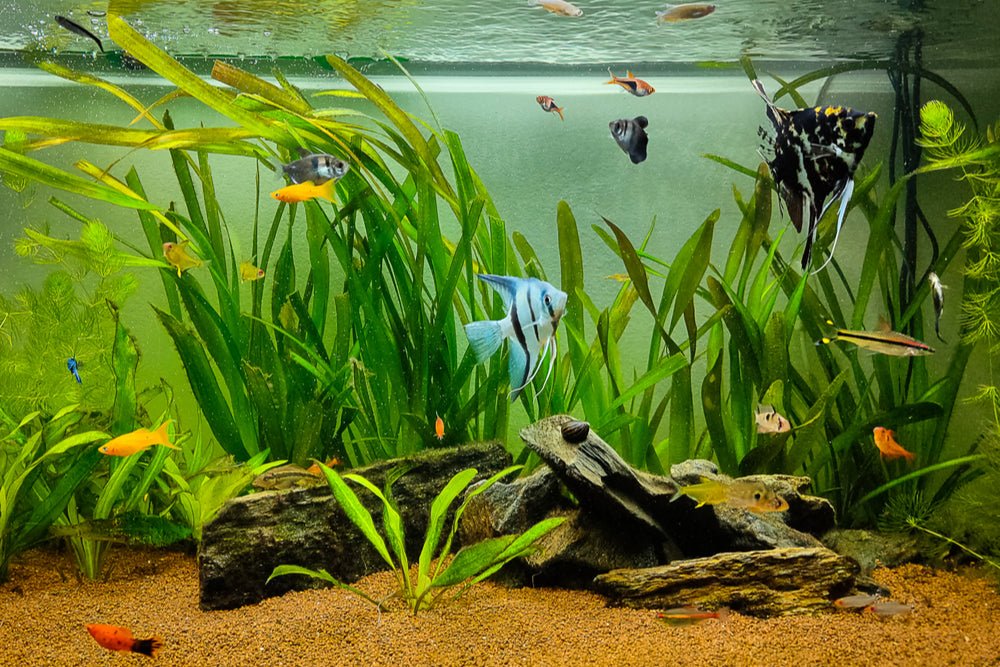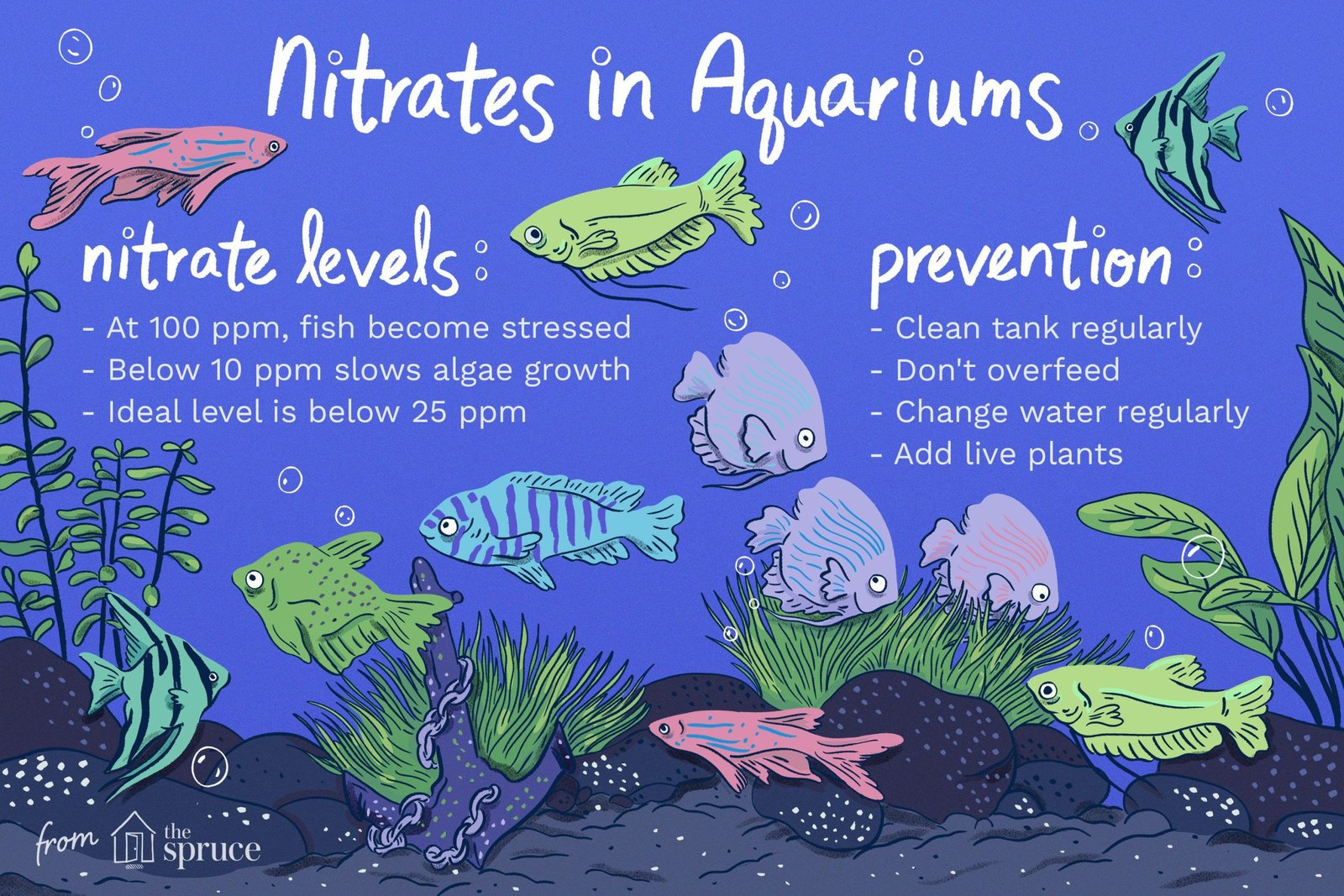To quickly reduce nitrate in a fish tank, perform routine water changes and add nitrate-reducing plants to the tank. Additionally, using a protein skimmer and adding items that support anaerobic bacteria growth can also help lower nitrate levels.
Regular maintenance and monitoring of water parameters are important when using plants to manage nitrate levels in the aquarium.

Credit: www.aquariumcoop.com
Understanding Nitrate In A Fish Tank
Lowering nitrate levels in a fish tank can be done quickly by performing routine water changes, adding nitrate-reducing plants, using a protein skimmer, and promoting the growth of anaerobic bacteria. Regular maintenance and monitoring are crucial to keeping nitrate levels in check.
What Are Nitrates?
Nitrates are compounds that naturally occur in fish tanks as a result of the nitrogen cycle. They are byproducts of the breakdown of fish waste, excess food, and decaying organic matter. Treating high nitrate levels in a fish tank is crucial for the well-being of your fish and the overall health of the aquarium.The Nitrogen Cycle
The nitrogen cycle is a natural process that occurs in all fish tanks. It involves the conversion of harmful ammonia (produced by fish waste) into less toxic compounds like nitrites and then nitrates. Understanding this cycle is key to managing nitrate levels effectively. During the nitrogen cycle, beneficial bacteria convert ammonia into nitrites through a process called nitrification. Nitrites, although less harmful than ammonia, can still be toxic to fish. Luckily, another group of bacteria convert nitrites into nitrates, which are relatively less toxic.Testing For Nitrate Levels
Testing for nitrate levels in your fish tank is essential to determine if there is a high concentration that needs to be reduced. Regular monitoring of nitrate levels is key to maintaining a healthy environment for your fish. There are several methods for testing nitrate levels, including liquid test kits, test strips, and digital testers. Liquid test kits are the most accurate and reliable option. Simply follow the instructions provided with the kit to obtain an accurate reading of nitrate levels in your fish tank. Note: It is important to always adhere to the instructions provided with the testing kit to ensure accurate results.
Credit: www.youtube.com
Methods For Quickly Reducing Nitrate
If you’re dealing with high nitrate levels in your fish tank, it’s crucial to take immediate action to maintain a healthy environment for your fish. In this article, we will discuss a few effective methods for quickly reducing nitrate in your fish tank.
Performing Routine Water Changes
Routine water changes are one of the most fundamental and effective ways to reduce nitrate levels in your fish tank. By replacing a portion of the water regularly, you dilute the nitrate concentration, effectively lowering it. To perform a water change, follow these steps:
- Prepare a separate container of dechlorinated water.
- Siphon out about 20-30% of the water from your tank.
- Carefully pour the new water into the tank, making sure it matches the temperature and pH levels of the existing water.
- Monitor the nitrate levels regularly and adjust the frequency of water changes as needed.
Adding Nitrate-reducing Plants
Nitrate-reducing plants are a natural and effective way to absorb and process excess nitrates in your fish tank. Here are a few examples of nitrate-reducing plants:
| Plant Name | Scientific Name |
|---|---|
| Coontail | Ceratophyllum demersum |
| Duckweeds | Lemna spp. |
| Limnobium laevigatum | Limnobium laevigatum |
| Water lettuce | Pistia stratiotes |
| Ceratopteris thalictroides | Ceratopteris thalictroides |
| Hygrophila difformis | Hygrophila difformis |
When adding nitrate-reducing plants, make sure to provide them with adequate lighting, nutrients, and CO2 supplementation if necessary. These plants will absorb the nitrates through their roots and leaves, helping to maintain a healthier nitrogen balance in your aquarium.
Using A Protein Skimmer
A protein skimmer is a device commonly used in saltwater aquariums to remove organic waste and excess nutrients, including nitrates. It works by creating tiny air bubbles that attract and collect organic molecules, which are then removed from the water column.
To use a protein skimmer in your fish tank:
- Choose a protein skimmer suitable for the size of your tank.
- Install the protein skimmer according to the manufacturer’s instructions.
- Regularly clean and maintain the skimmer to ensure it functions optimally.
A protein skimmer can be an effective tool for reducing nitrate levels in your fish tank, especially in systems that have a high bioload or are prone to nutrient buildup.
By utilizing these methods for quickly reducing nitrate, you can create a healthier and more stable environment for your fish. Remember to monitor your nitrate levels regularly and make adjustments as needed to maintain optimal water conditions.
Long-term Strategies For Maintaining Low Nitrate Levels
Maintaining low nitrate levels in a fish tank requires performing routine water changes, adding nitrate-reducing plants, using a protein skimmer, and supporting the growth of anaerobic bacteria. These strategies help reduce nitrate levels quickly and promote a healthy aquarium.
Supporting Anaerobic Bacteria Growth
Supporting anaerobic bacteria growth in your fish tank is crucial for long-term maintenance of low nitrate levels. Anaerobic bacteria play a vital role in converting nitrates into harmless nitrogen gas, helping to keep your aquarium healthy and balanced. One way to support anaerobic bacteria growth is by incorporating live rock or biological media into your tank setup. These porous materials provide a habitat for anaerobic bacteria to thrive, allowing them to break down nitrate compounds effectively. Additionally, you can create an anaerobic zone within your tank by using a deep sand bed or a denitrifying filter. These systems provide an oxygen-free environment where anaerobic bacteria can flourish, converting nitrates into nitrogen gas.Proper Aquarium Maintenance
Regular and proper aquarium maintenance is essential for maintaining low nitrate levels in the long term. Here are some maintenance practices that you should follow: 1. Perform routine water changes: Regular water changes help remove built-up nitrates in the aquarium. Aim to replace 10-20% of the water every two weeks to keep nitrate levels in check. 2. Clean filters and equipment: Regularly clean your filters, skimmers, and any other equipment to prevent debris buildup. This will ensure optimal performance and prevent excess nitrates from accumulating. 3. Vacuum the substrate: Use a gravel vacuum to remove any leftover food, waste, or decaying matter from the substrate. This will prevent nitrate-producing bacteria from proliferating. 4. Test water parameters: Regularly test nitrate levels in your aquarium using a reliable test kit. This will help you monitor the effectiveness of your maintenance routine and make adjustments if necessary.Managing Livestock Population
Properly managing the population of fish and other livestock in your aquarium is crucial for maintaining low nitrate levels in the long term. Overstocking can lead to an excessive amount of organic waste, which will inevitably increase nitrate levels. To prevent overstocking, consider the following tips: 1. Plan carefully when selecting fish: Research the adult size and behavior of each species before adding them to your aquarium. Avoid adding species that are known for producing excessive waste or growing too large for your tank. 2. Regularly monitor livestock growth: As your fish grow, their waste production will increase. It’s important to monitor and reevaluate the maximum capacity of your tank to avoid overcrowding. By implementing these long-term strategies, you can effectively reduce nitrate levels and create a healthy, thriving environment for your fish and other aquatic life. Remember to regularly test water parameters and make adjustments as needed to ensure optimal conditions in your fish tank.:strip_icc()/black-and-white-striped-fish-in-fish-tank-588278996-5aa87591a9d4f90036d2f36f.jpg)
Credit: www.thesprucepets.com
Frequently Asked Questions For How To Quickly Reduce Nitrate In A Fish Tank
How Do I Lower My Aquarium Nitrates Fast?
To lower aquarium nitrates fast, perform routine water changes, add nitrate-reducing plants, use a protein skimmer, and add items that support anaerobic bacteria growth. Regular maintenance and monitoring of water parameters are important for managing nitrate levels in an aquarium.
How Long Does It Take For Nitrate Levels To Go Down In Aquarium?
The time it takes for nitrate levels to decrease in an aquarium depends on various factors. However, you can reduce nitrate levels faster by performing routine water changes, adding nitrate-reducing plants, using a protein skimmer, and promoting anaerobic bacteria growth with appropriate items.
Regular monitoring and maintenance are essential for managing nitrate levels effectively.
What Absorbs Nitrates In Aquarium?
Plants such as Anacharis, Hornwort, and Java Moss absorb nitrates in aquariums. Regular maintenance and monitoring of water parameters are important for managing nitrate levels.
What Neutralizes Nitrates In Water?
Ion exchange units, reverse osmosis, and distillation can neutralize nitrates in water. Boiling water does not remove nitrates and actually increases their concentrations.
Conclusion
To quickly reduce nitrate in a fish tank, you can perform routine water changes, add nitrate-reducing plants, use a protein skimmer, and add items that support anaerobic bacteria growth. These methods are effective in maintaining healthy nitrate levels in your aquarium.
Additionally, plants such as Anacharis, Hornwort, and Java Moss are also helpful in reducing nitrates. Regular maintenance and monitoring of water parameters are important for managing nitrate levels. Consider using ion exchange units, reverse osmosis, or distillation to remove nitrate from drinking water.
Remember, boiling water does not remove nitrates and can actually increase their concentrations.


